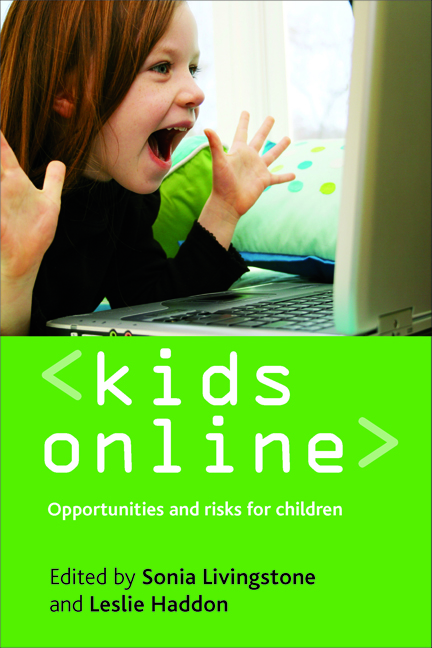Book contents
- Frontmatter
- Contents
- Notes on contributors
- Acknowledgements
- one Introduction
- Section I Researching European children online
- Section II Going online: new opportunities?
- Section III Going online: new risks?
- Section IV Policy implications
- Appendix A List of country codes
- Appendix B Children and parents online, by country
- Appendix C The EU Kids Online network
fifteen - Maximising opportunities and minimising risks for children online
Published online by Cambridge University Press: 15 July 2022
- Frontmatter
- Contents
- Notes on contributors
- Acknowledgements
- one Introduction
- Section I Researching European children online
- Section II Going online: new opportunities?
- Section III Going online: new risks?
- Section IV Policy implications
- Appendix A List of country codes
- Appendix B Children and parents online, by country
- Appendix C The EU Kids Online network
Summary
Protecting or inspiring our children
New and increasingly interactive technologies provide opportunities for children and young people to communicate personal textual and visual information in publicly accessible and searchable online spaces. These new uses not only potentially promote sociability, self-confidence and identity formation, they may also expose children and young people to a variety of risks to their physical and psychological well-being (Hasebrink et al, 2009). In the European Union (EU), several measures have been deployed to promote safer use of the internet by children and young people, often inspired or driven by the Safer Internet Action Plan (1999-2004), Safer Internet Plus Programme (2005-08) or Safer Internet Programme (2009-13). These EU initiatives are evaluated on a regular basis and supported by research into online risks (for example Staksrud, 2005; EC, 2006, 2007, 2008; Deloitte Enterprise Risk Services, 2008). Yet participants at the 2007 Safer Internet Forum still found it necessary to call for reliable facts and figures to inform future work on online safety.
Guided by a conceptual framework including different forms of online risks and opportunities, this chapter makes policy recommendations regarding children's use of the internet. It asks how positive uses of new technologies can be stimulated, what we can learn from existing research on how to prevent children from harm in online environments and how children can learn to cope with negative experiences. Realising that providing opportunities is one possible way to reduce risks, the classification of opportunities and risks builds on a three Cs approach: content, contact and conduct. This classification derives from the three modes of communication afforded by the internet:
• Content: one-to-many (child as recipient of mass distributed content)
• Contact: adult/child-to-child (child as participant in an interactive situation)
• Conduct: peer-to-peer (child as actor in an interaction in which s/he may be the initiator or perpetrator)
Using each mode of communication, children may encounter risks to their development and well-being. On the other hand, they also have access to many online opportunities such as education and learning, identity formation and social connection. With the evidence base of the EU Kids Online project as a guiding resource, and drawing on the conceptual framework developed in Hasebrink et al (2009; see also Chapter Four, this volume), the policy recommendations in this chapter address both maximising opportunities and minimising risks for children online.
- Type
- Chapter
- Information
- Kids OnlineOpportunities and Risks for Children, pp. 187 - 198Publisher: Bristol University PressPrint publication year: 2009



